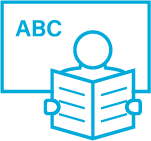Assisted Repeated Reading with an Advanced-level Japanese EFL Reader: A Longitudinal Diary Study

The present study attempts to reveal the inner process of foreign language L2 reading fluency development through repeated reading (RR) for an advanced-level L2 reader. This study was designed to investigate specifically how her reading fluency developed and how her comprehension changed during the course of RR treatment over 14 weeks.
Authors: Etsuo Taguchi, Greta Gorsuch, Miyoko Takayasu-Maass & Kirsten Snipp
Source: Taguchi, E., Gorsuch, G., Takayasu-Maass, M., & Snipp, K. (2012). Assisted repeated reading with an advanced-level Japanese EFL reader: A longitudinal diary study. Reading in a Foreign Language, 24(1), 30–55.
Reading fluency has become a priority issue in English as a first language (L1) setting, and also in English as a second or foreign language (L2) setting, because the lack of fluency is considered a major obstacle to developing independent readers with good comprehension skills. Repeated Reading (RR) may be a promising approach for building fluency and comprehension in L2 settings. However, L2 fluency research has not yet demonstrated a strong correlation as in L1 settings between improved reading fluency and enhanced comprehension. The present study attempts to reveal the inner process of L2 reading fluency development through RR for an advanced-level L2 reader. This study was designed to investigate specifically how her reading fluency developed and how her comprehension changed during the course of RR treatment during 14 weeks.
- Fluent English monolingual (L1) readers usually read texts at 250 to 300 words per minute (wpm), while advanced-level L2 readers with good comprehension skills read texts at 80 to 120 wpm.
- Both L1 and L2 readers vary their reading rate according to task types or text difficulty levels.
- Both L1 and L2 readers of English who have acquired some fluency are likely to engage in a greater amount of reading than those who lack fluency.
- Both L1 and L2 fluency researchers concur that fluent readers engage in automatic, accurate, and rapid recognition of letters, letter combinations, and words.
- There have been multiple approaches to developing L2 reading fluency, such as extensive reading (ER), speed reading, and RR.
- The theoretical backbone of RR is automaticity theory (LaBerge & Samuels, 1974).
- Readers trained to a level of automaticity in word recognition should be able to direct more attention to higher-order resource-demanding comprehension processes.
- In English L1 settings, research has provided robust evidence to support this claim; however, in English L2 settings it is less clear.
- Multiple exposure to texts together with an audio reading model may provide some scaffolding for the beginning-level participants and may also engender motivation to read.

The study
The current study explores some currently unresolved issues. First, it is not known whether L2 reading fluency develops in ways that are similar to or different from L1 reading fluency, nor whether fluency training is effective at the same ages or ability levels. A second issue is what is happening with readers’ thinking while they engage in RR. A diary study is ‘a first-person account of a language learning or teaching experience, documented through regular, candid entries’ (Bailey, 1990, p. 215).
Research questions:
- How does an advanced-level L2 learner develop her silent reading rate and reading comprehension with RR?
- What features of RR are beneficial (and what are not) to the reading comprehension of the participant?
- What aspects of using an audio model are beneficial (and what are not) to the comprehension of the participant?
The participant was a 34-year-old Japanese housewife called ‘Naomi’, with advanced level English proficiency. She took pre- and post-tests of reading comprehension and time (the training procedure used different texts than those used for the pre- and post-tests).
Training procedure
- The 70 training sessions during the 14 weeks consisted of the following 4 steps:
- Read a passage from the RR text silently while timing the first reading time with a stopwatch.
- Read the same passage three more times while listening to the audio recording.
- Read the same passage again twice silently while timing each reading with a stopwatch.
- Write thoughts and comments about the RR session in a diary.
- The self-reported amount of reading for each session varied from 280 to 1364 words of text, with an average of 804 words.

Findings
- A pronounced practice effect is shown in how Naomi’s mean reading rate increased from the first to the fifth and sixth readings (averaged across the entire course of the RR treatments).
- Her first reading rates reflect transfer of her cumulative practice effect from the previous RR sessions.
- Her reading rate increased from pre-test to post-test by 24 wpm.
- Her comprehension score on the first taking of the post-test was 8/15, doubling her score from the pre-test.
- According to qualitative data, RR benefits reading comprehension in the following ways:
- RR enhances overall comprehension of passages.
- RR enhances comprehension of specific parts of passages.
- RR seems to provide scaffolding.
- However, RR may lead to reader boredom and demotivation and cannot alone lead a reader to better comprehension beyond a certain level.
Beneficial and non-beneficial effects of the audio model
- The audio reading model paces the reader and helps increase reading speed.
- The audio reading model helps with comprehension of dialogues in the text.
- The audio reading model gives the reader access to the pronunciation of words.
- The audio reading model does not help the reader’s comprehension of ambiguous parts of text.

Conclusions and implications
RR improved reading rate and comprehension. Enhanced comprehension may come from the various forms of scaffolding that RR is believed to support L2 readers. The scaffolding may bridge the gap between what a reader can do currently and what they will be able to do in the future. The audio reading model paced the reading and helped the learner to read faster. It also helped her to understand dialogues embedded in the text by providing character-specific prosodic information. Naomi suggested that three re-readings after the initial reading in each session would be sufficient. Readers should also be given the opportunity to confirm the accuracy of the assumed meaning of unknown words and phrases before continuing to the next rereading.